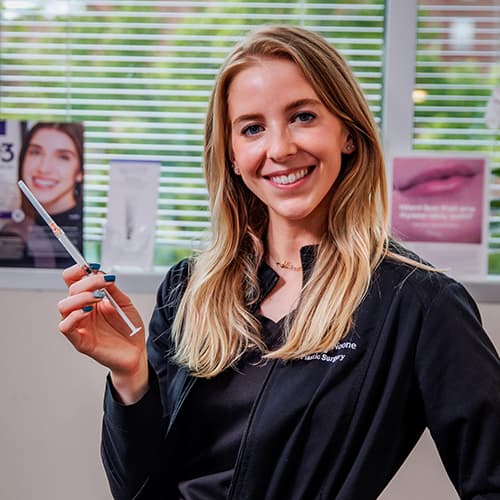Facelift vs Fillers: Which is the Better Anti-Aging Option?

Two of the most popular anti-aging treatments are facelifts and dermal fillers. Both options can achieve outstanding results, but depending on your needs and goals, one may be better suited for you than the other.
Here, double-board certified plastic surgeon and facial rejuvenation expert Dr. R. Brannon Claytor explains the key differences between facelift vs. fillers to help you make a confident, informed decision.
What is the difference between a facelift and fillers?
A facelift (rhytidectomy) is a surgical procedure designed to lift and reposition deeper layers of the face and neck to address sagging skin, jowls, deep creases, and volume loss at a structural level. During surgery, Dr. Claytor carefully lifts and repositions the underlying muscles (SMAS layer), tightens loose skin, and removes excess tissue to create a smoother, firmer, and more youthful appearance.
A facelift is not simply about tightening the skin; it restores the youthful architecture of the face by vertically lifting what has descended over time.
In contrast, dermal fillers are injectable treatments that add physical volume to specific areas of the face to smooth wrinkles, plump thinning features, and subtly reshape facial contours. Most filler brands, such as Juvéderm®, Restylane®, and RHA®, are made from hyaluronic acid, a substance naturally found in the body that binds with water to hydrate and volumize the skin.
In short, while both facelifts and fillers rejuvenate the face, they do so differently:
- A facelift reshapes and lifts the facial structure to correct sagging and significant aging.
- Fillers plump and smooth specific areas without altering the underlying structures.
Can fillers replace a facelift?
Fillers can offer a non-surgical, temporary alternative for patients with mild to moderate signs of aging, but they are not a true replacement for the comprehensive results of a facelift. While fillers are excellent for treating early signs of aging, they are limited in their ability to correct advanced sagging, deep folds, or loose skin.
One of the main reasons fillers can’t replace a facelift is that they work by adding volume rather than lifting or tightening the underlying structures. In patients with more significant aging, repeatedly adding filler to areas of volume loss can lead to an overfilled, heavy appearance, sometimes referred to as “filler fatigue.” Rather than restoring natural contours, excessive filler may obscure the natural beauty of the face.
Remember, a facelift resets the foundation of the face by repositioning deep tissues that have descended with age and removes excess, stretched skin. This comprehensive approach corrects jowling, redefines the jawline, and restores balance to the facial proportions—results that cannot be achieved with injectable treatments alone.
“I am beyond pleased with the outcome of my Deep Plane Facelift! I wanted a natural, not an overdone look, and I got it!! The recovery time was better than expected and Dr. Claytor and staff were extremely helpful and supportive throughout the entire process. A++++++! I highly recommend Claytor Noone Plastic Surgery”
How long do fillers last vs facelift results?
The longevity of your results is an important consideration when choosing between fillers and a facelift:
- Fillers typically last 6 to 24 months, depending on the product and the area treated. They require regular maintenance treatments to sustain results.
- Facelift results can last 10 years or more. While your face will continue to age naturally after surgery, you will still look more youthful than if you had never undergone the procedure.
Fillers are a popular option for early signs of aging because they are minimally invasive, require little to no downtime, and deliver immediate results.

When should you consider upgrading from fillers to a facelift?
At our Philadelphia plastic surgery practice, Dr. Claytor meets regularly with patients who have enjoyed the benefits of fillers for years but have reached a point where non-surgical options no longer deliver the youthful, natural look they desire.
At a certain point, relying solely on injectables can actually accentuate heaviness or distort natural facial proportions. Transitioning to a facelift at the right time preserves a fresh, natural appearance without the risk of looking overdone.
Additionally, for many patients, signs of aging extend below the jawline. Concerns such as a heavy or poorly defined neck, visible vertical bands, or excess skin (often called a “turkey neck”) are also indicators that a facelift (often in combination with a neck lift) is much better suited to achieve the natural and lasting rejuvenation patients seek.
- Related: Can fillers make you look older?
As experienced injectors, both Dr. Claytor and our Physician Assistant, Julie Holesh, are highly skilled at recognizing when fillers can enhance your results—and when it may be time to consider a facelift for the best outcome.
Julie Holesh, PA
Physician assistant Julie Holesh is board-certified by the National Commission on Certification of Physician Assistants. With both an artistic eye and medical expertise, she can help you achieve optimal skin quality with injectables, laser treatments, and other med spa services.
You might consider moving from fillers to a facelift when:
- You are requiring more filler volume to maintain your results, risking an unnatural or puffy appearance that masks your natural bone structure.
- Fillers no longer adequately lift sagging skin, especially along key areas like the jawline, cheeks, and neck, where volume alone cannot correct underlying laxity.
- You desire a more significant, longer-lasting rejuvenation with minimal future maintenance, rather than returning every few months for touch-ups.
One of the advantages of working with an expert injector like Dr. Claytor or Julie is that they will be completely honest with you about the limits of non-surgical treatments. If your facial aging has progressed to the point where fillers are no longer the best tool to achieve a natural look, they will guide you toward surgical options that align with your aesthetic goals.
In these cases, a facelift allows Dr. Claytor to reset your facial structure in a way that looks refreshed and authentic, not “overdone.” Many patients find that transitioning to a facelift at the right time is a better long-term investment that provides more beautiful and lasting results.
Can fillers complement a facelift?
Yes! Many patients benefit from a combined approach. After a facelift repositions deep tissues, fillers can be used to fine-tune facial features by restoring soft, youthful volume to the lips, cheeks, temples, and under-eye areas for the most harmonious results possible.
In many cases, Dr. Claytor recommends facial fat transfer, particularly to the temples and under-eye areas, as a more permanent alternative to fillers for patients undergoing facelift surgery. Fat grafting offers long-lasting volume enhancement using your body’s own natural tissues, and may be performed either during your facelift or in a separate procedure.
Which is better for you: facelift or fillers?
Choosing between a facelift and fillers ultimately depends on your unique anatomy, aesthetic goals, timeline, and personal preferences.
- Choose fillers if you have mild signs of aging, such as early volume loss, fine lines, or minor contour changes, and want subtle, temporary enhancements with little to no downtime.
- Choose a facelift if you seek significant, lasting rejuvenation for moderate to severe aging concerns and want a worthwhile investment for a one-time procedure that can deliver natural, youthful results for many years.
We carefully evaluate the cause of your concerns—whether it’s volume loss, skin laxity, or both—to recommend whether a facelift, fillers, or a combination of both will best help you achieve your goals.
Ready to find your best anti-aging solution?
Schedule your personal consultation with Dr. Claytor to explore your options and receive a personalized plan for turning back the clock on aging. Call our Philadelphia office at 610-527-4833, or fill out the form below and we will reach out to you!

